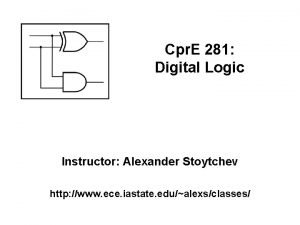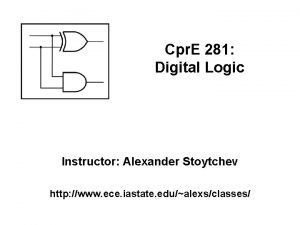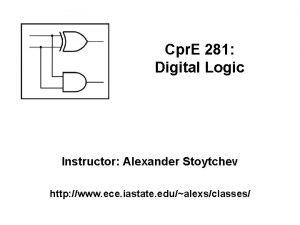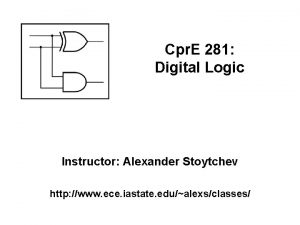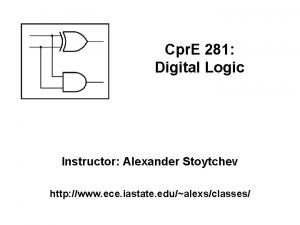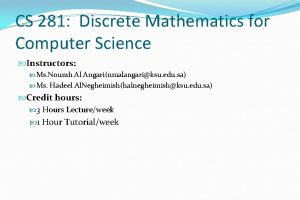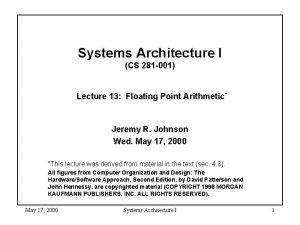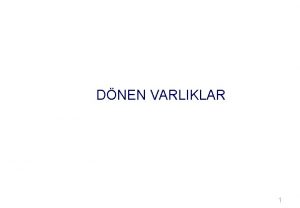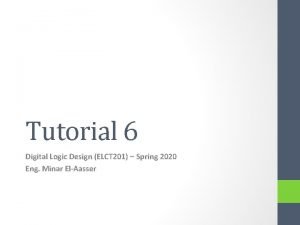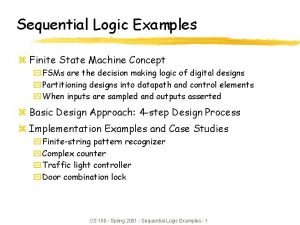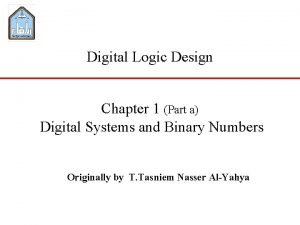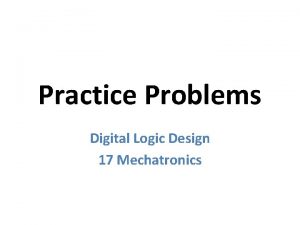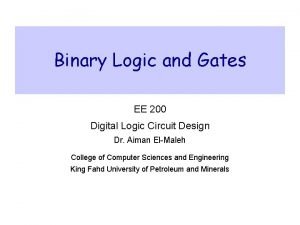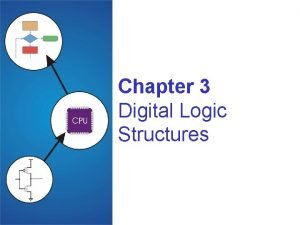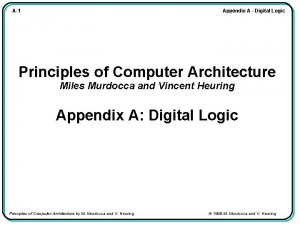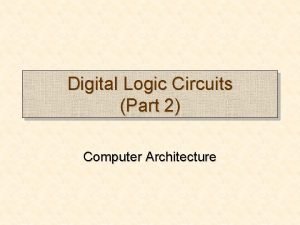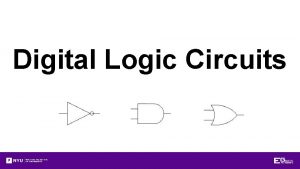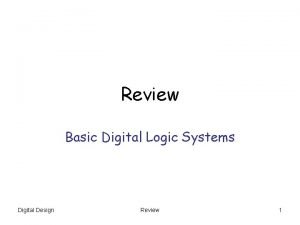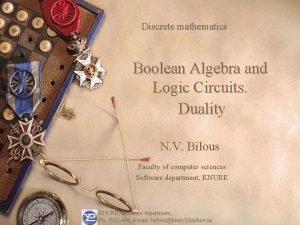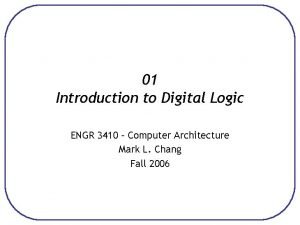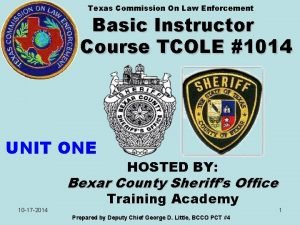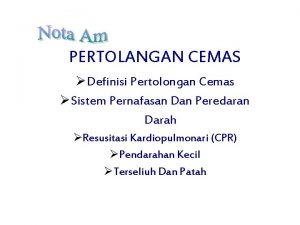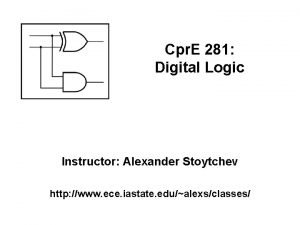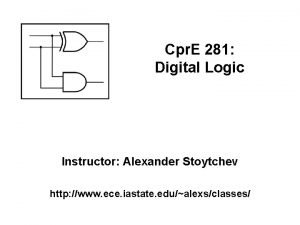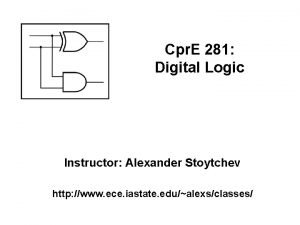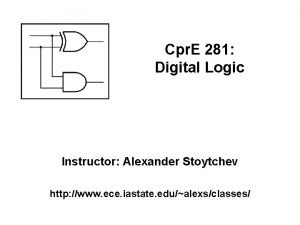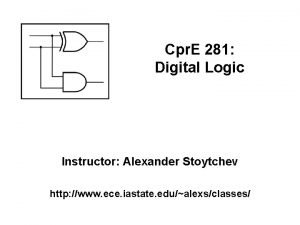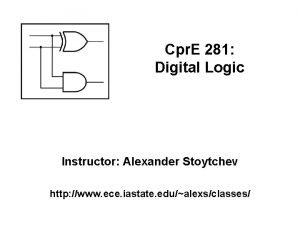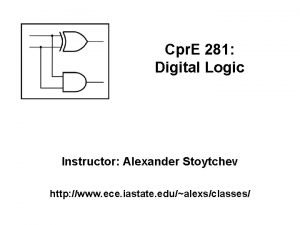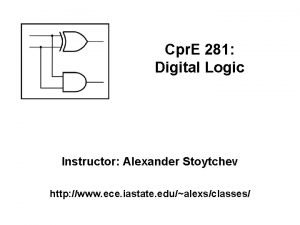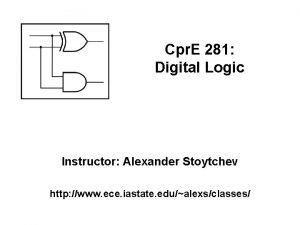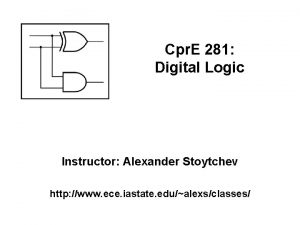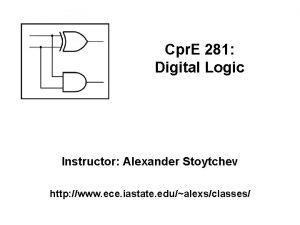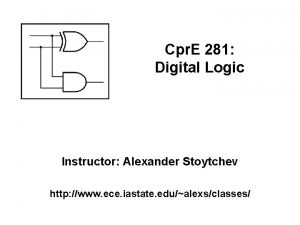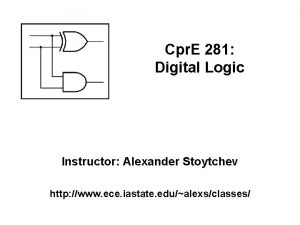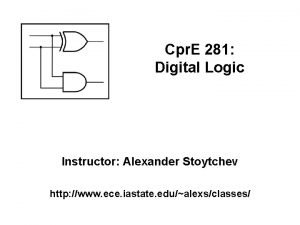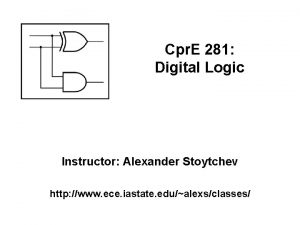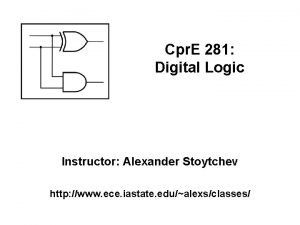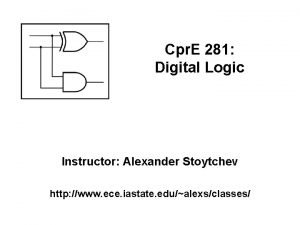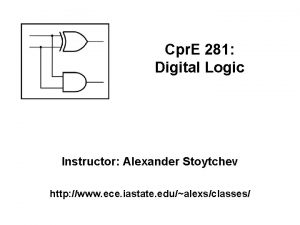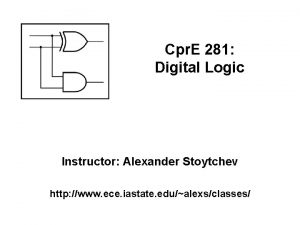Cpr E 281 Digital Logic Instructor Alexander Stoytchev

























![Building an AND gate with NAND gates [http: //en. wikipedia. org/wiki/NAND_logic] Building an AND gate with NAND gates [http: //en. wikipedia. org/wiki/NAND_logic]](https://slidetodoc.com/presentation_image/2d8fdc5d1f7a40ae5eb867ae3999d0b9/image-26.jpg)
![Building an OR gate with NAND gates [http: //en. wikipedia. org/wiki/NAND_logic] Building an OR gate with NAND gates [http: //en. wikipedia. org/wiki/NAND_logic]](https://slidetodoc.com/presentation_image/2d8fdc5d1f7a40ae5eb867ae3999d0b9/image-27.jpg)

![NOR gate with NAND gates [http: //en. wikipedia. org/wiki/NAND_logic] NOR gate with NAND gates [http: //en. wikipedia. org/wiki/NAND_logic]](https://slidetodoc.com/presentation_image/2d8fdc5d1f7a40ae5eb867ae3999d0b9/image-29.jpg)
![XOR gate with NAND gates [http: //en. wikipedia. org/wiki/NAND_logic] XOR gate with NAND gates [http: //en. wikipedia. org/wiki/NAND_logic]](https://slidetodoc.com/presentation_image/2d8fdc5d1f7a40ae5eb867ae3999d0b9/image-30.jpg)
![XNOR gate with NAND gates [http: //en. wikipedia. org/wiki/NAND_logic] XNOR gate with NAND gates [http: //en. wikipedia. org/wiki/NAND_logic]](https://slidetodoc.com/presentation_image/2d8fdc5d1f7a40ae5eb867ae3999d0b9/image-31.jpg)




![Building an OR gate with NOR gates [http: //en. wikipedia. org/wiki/NOR_logic] Building an OR gate with NOR gates [http: //en. wikipedia. org/wiki/NOR_logic]](https://slidetodoc.com/presentation_image/2d8fdc5d1f7a40ae5eb867ae3999d0b9/image-36.jpg)


![NAND gate with NOR gates [http: //en. wikipedia. org/wiki/NOR_logic] NAND gate with NOR gates [http: //en. wikipedia. org/wiki/NOR_logic]](https://slidetodoc.com/presentation_image/2d8fdc5d1f7a40ae5eb867ae3999d0b9/image-39.jpg)
![XOR gate with NOR gates [http: //en. wikipedia. org/wiki/NOR_logic] XOR gate with NOR gates [http: //en. wikipedia. org/wiki/NOR_logic]](https://slidetodoc.com/presentation_image/2d8fdc5d1f7a40ae5eb867ae3999d0b9/image-40.jpg)
![XNOR gate with NOR gates [http: //en. wikipedia. org/wiki/NOR_logic] XNOR gate with NOR gates [http: //en. wikipedia. org/wiki/NOR_logic]](https://slidetodoc.com/presentation_image/2d8fdc5d1f7a40ae5eb867ae3999d0b9/image-41.jpg)

![[ Platt 2009 ] [ Platt 2009 ]](https://slidetodoc.com/presentation_image/2d8fdc5d1f7a40ae5eb867ae3999d0b9/image-43.jpg)
![[ Platt 2009 ] [ Platt 2009 ]](https://slidetodoc.com/presentation_image/2d8fdc5d1f7a40ae5eb867ae3999d0b9/image-44.jpg)
![[ Platt 2009 ] [ Platt 2009 ]](https://slidetodoc.com/presentation_image/2d8fdc5d1f7a40ae5eb867ae3999d0b9/image-45.jpg)
































- Slides: 77

Cpr. E 281: Digital Logic Instructor: Alexander Stoytchev http: //www. ece. iastate. edu/~alexs/classes/

NAND and NOR Logic Networks Cpr. E 281: Digital Logic Iowa State University, Ames, IA Copyright © Alexander Stoytchev

Administrative Stuff • HW 2 is due today

Administrative Stuff • HW 3 is out • It is due on Monday Feb 3 @ 4 pm. • Please write clearly on the first page (in BLOCK CAPITAL letters) the following three things: § Your First and Last Name § Your Student ID Number § Your Lab Section Letter • Also, please § Staple your pages § Use Letter-sized sheets

Quick Review

The Three Basic Logic Gates x x NOT gate x 1 x 2 x 1 × x 2 AND gate x 1 x 2 x 1 + x 2 OR gate [ Figure 2. 8 from the textbook ]

Truth Table for NOT x x 0 1 1 0

Truth Table for AND x 1 x 2 x 1 × x 2

Truth Table for OR x 1 x 2 x 1 + x 2

De. Morgan’s Theorem

Two New Logic Gates

NAND Gate x 1 0 0 1 1 x 2 0 1 f 1 1 1 0

NOR Gate x 1 0 0 1 1 x 2 0 1 f 1 0 0 0

AND vs NAND x x 1 x ×x 1 2 2 x 1 0 0 1 1 x 2 0 1 f 0 0 0 1 x ×x 1 2 x 1 x 2 x 1 0 0 1 1 x 2 0 1 f 1 1 1 0

AND followed by NOT = NAND x x x ×x 1 2 1 x ×x 1 2 x 1 x 2 2 x 1 0 0 1 1 x 2 0 1 f 0 0 0 1 f 1 1 1 0 x 1 0 0 1 1 x 2 0 1 f 1 1 1 0

NAND followed by NOT = AND x ×x 1 2 x 1 x ×x 1 2 x x x 1 0 0 1 1 x 2 0 1 f 1 1 1 0 f 0 0 0 1 x ×x 1 2 x 1 0 0 1 1 x 2 0 1 f 0 0 0 1

OR vs NOR x 1 x 2 x 1 + x 2 x 1 0 0 1 1 x 2 0 1 f 0 1 1 1 x 1 0 0 1 1 x 2 0 1 f 1 0 0 0

OR followed by NOT = NOR x 1 + x 2 x 1 0 0 1 1 x 2 0 1 f 0 1 1 1 x 1 + x 2 f 1 0 0 0 x 1 0 0 1 1 x 2 0 1 f 1 0 0 0

NOR followed by NOT = OR x 1 + x 2 x 1 0 0 1 1 x 2 0 1 f 1 0 0 0 f 0 1 1 1 x 1 + x 2 x 1 0 0 1 1 x 2 0 1 f 0 1 1 1

Why do we need two more gates?

Why do we need two more gates? They can be implemented with fewer transistors. (more about this later)

They are simpler to implement, but are they also useful?

Building a NOT Gate with NAND x x 0 1 1 0 x x x 0 0 1 1 x 0 1 f 1 1 1 0

Building a NOT Gate with NAND x x x 0 1 x 1 0 x x x 0 0 1 1 x 0 1 f 1 1 1 0 impossible combinations

Building a NOT Gate with NAND x x x 0 1 x 1 0 x x x 0 0 1 1 x 0 1 f 1 1 1 0 Thus, the two truth tables are equal! impossible combinations
![Building an AND gate with NAND gates http en wikipedia orgwikiNANDlogic Building an AND gate with NAND gates [http: //en. wikipedia. org/wiki/NAND_logic]](https://slidetodoc.com/presentation_image/2d8fdc5d1f7a40ae5eb867ae3999d0b9/image-26.jpg)
Building an AND gate with NAND gates [http: //en. wikipedia. org/wiki/NAND_logic]
![Building an OR gate with NAND gates http en wikipedia orgwikiNANDlogic Building an OR gate with NAND gates [http: //en. wikipedia. org/wiki/NAND_logic]](https://slidetodoc.com/presentation_image/2d8fdc5d1f7a40ae5eb867ae3999d0b9/image-27.jpg)
Building an OR gate with NAND gates [http: //en. wikipedia. org/wiki/NAND_logic]

Implications Any Boolean function can be implemented with only NAND gates!
![NOR gate with NAND gates http en wikipedia orgwikiNANDlogic NOR gate with NAND gates [http: //en. wikipedia. org/wiki/NAND_logic]](https://slidetodoc.com/presentation_image/2d8fdc5d1f7a40ae5eb867ae3999d0b9/image-29.jpg)
NOR gate with NAND gates [http: //en. wikipedia. org/wiki/NAND_logic]
![XOR gate with NAND gates http en wikipedia orgwikiNANDlogic XOR gate with NAND gates [http: //en. wikipedia. org/wiki/NAND_logic]](https://slidetodoc.com/presentation_image/2d8fdc5d1f7a40ae5eb867ae3999d0b9/image-30.jpg)
XOR gate with NAND gates [http: //en. wikipedia. org/wiki/NAND_logic]
![XNOR gate with NAND gates http en wikipedia orgwikiNANDlogic XNOR gate with NAND gates [http: //en. wikipedia. org/wiki/NAND_logic]](https://slidetodoc.com/presentation_image/2d8fdc5d1f7a40ae5eb867ae3999d0b9/image-31.jpg)
XNOR gate with NAND gates [http: //en. wikipedia. org/wiki/NAND_logic]


Building a NOT Gate with NOR x x 0 1 1 0 x x x 0 0 1 1 x 0 1 f 1 0 0 0

Building a NOT Gate with NOR x x x 0 1 x 1 0 x x x 0 0 1 1 x 0 1 f 1 0 0 0 impossible combinations

Building a NOT Gate with NOR x x x 0 1 x 1 0 x x x 0 0 1 1 x 0 1 f 1 0 0 0 Thus, the two truth tables are equal! impossible combinations
![Building an OR gate with NOR gates http en wikipedia orgwikiNORlogic Building an OR gate with NOR gates [http: //en. wikipedia. org/wiki/NOR_logic]](https://slidetodoc.com/presentation_image/2d8fdc5d1f7a40ae5eb867ae3999d0b9/image-36.jpg)
Building an OR gate with NOR gates [http: //en. wikipedia. org/wiki/NOR_logic]

Let’s build an AND gate with NOR gates

Implications Any Boolean function can be implemented with only NOR gates!
![NAND gate with NOR gates http en wikipedia orgwikiNORlogic NAND gate with NOR gates [http: //en. wikipedia. org/wiki/NOR_logic]](https://slidetodoc.com/presentation_image/2d8fdc5d1f7a40ae5eb867ae3999d0b9/image-39.jpg)
NAND gate with NOR gates [http: //en. wikipedia. org/wiki/NOR_logic]
![XOR gate with NOR gates http en wikipedia orgwikiNORlogic XOR gate with NOR gates [http: //en. wikipedia. org/wiki/NOR_logic]](https://slidetodoc.com/presentation_image/2d8fdc5d1f7a40ae5eb867ae3999d0b9/image-40.jpg)
XOR gate with NOR gates [http: //en. wikipedia. org/wiki/NOR_logic]
![XNOR gate with NOR gates http en wikipedia orgwikiNORlogic XNOR gate with NOR gates [http: //en. wikipedia. org/wiki/NOR_logic]](https://slidetodoc.com/presentation_image/2d8fdc5d1f7a40ae5eb867ae3999d0b9/image-41.jpg)
XNOR gate with NOR gates [http: //en. wikipedia. org/wiki/NOR_logic]

The following examples came from this book
![Platt 2009 [ Platt 2009 ]](https://slidetodoc.com/presentation_image/2d8fdc5d1f7a40ae5eb867ae3999d0b9/image-43.jpg)
[ Platt 2009 ]
![Platt 2009 [ Platt 2009 ]](https://slidetodoc.com/presentation_image/2d8fdc5d1f7a40ae5eb867ae3999d0b9/image-44.jpg)
[ Platt 2009 ]
![Platt 2009 [ Platt 2009 ]](https://slidetodoc.com/presentation_image/2d8fdc5d1f7a40ae5eb867ae3999d0b9/image-45.jpg)
[ Platt 2009 ]

De. Morgan’s theorem in terms of logic gates x 1 x 2 (a) x 1 x 2 = x 1 + x 2

De. Morgan’s theorem in terms of logic gates x 1 x 2 (b) x 1 + x 2 = x 1 x 2

Function Synthesis

Using NAND gates to implement a sum-of-products x 1 x 2 x 3 x 4 x 5 [ Figure 2. 27 from the textbook ]

Using NOR gates to implement a product-of sums x 1 x 2 x 3 x 4 x 5 [ Figure 2. 28 from the textbook ]

Example 2. 13

NOR-gate realization of the function x 1 x 2 f x 3 (a) POS implementation x 1 x 2 f x 3 (b) NOR implementation [ Figure 2. 29 from the textbook ]

Example 2. 10

NAND-gate realization of the function x 1 f x 2 x 3 (a) SOP implementation x 1 f x 2 x 3 (b) NAND implementation [ Figure 2. 30 from the textbook ]


Appendix B Implementation Technology

Figure B. 1. Logic values as voltage levels.

x = "low" x = "high" (a) A simple switch controlled by the input x Gate Source Drain Substrate (Body) (b) NMOS transistor VG VS VD (c) Simplified symbol for an NMOS transistor Figure B. 2. NMOS transistor as a switch.

x = "high" x = "low" (a) A switch with the opposite behavior of Figure 3. 2 a Gate Drain Source Substrate (Body) VDD (b) PMOS transistor VG VS VD (c) Simplified symbol for a PMOS transistor Figure B. 3. PMOS transistor as a switch.

VD VD = 0 V VD VG VS = 0 V Closed switch when. VG = VDD Open switch when. VG = 0 V (a) NMOS transistor VS = VDD VDD VD VD VD = VDD VG Open switch when. VG = VDD Closed switch when. VG = 0 V (b) PMOS transistor Figure B. 4. NMOS and PMOS transistors in logic circuits.

VDD R 5 V R + Vf - Vf Vx Vx (a) Circuit diagram x (b) Simplified circuit diagram f x f (c) Graphical symbols Figure B. 5. A NOT gate built using NMOS technology.

VDD Vf Vx 1 Vx 2 (a) Circuit x 1 x 2 f 0 0 1 1 1 0 0 1 (b) Truth table f x 1 x 2 f (c) Graphical symbols Figure B. 6. NMOS realization of a NAND gate.

Figure B. 7. NMOS realization of a NOR gate.

VDD Vf A Vx 1 Vx 2 f f 0 0 1 1 0 0 0 1 0 1 (b) Truth table (a) Circuit x 1 x 2 f (c) Graphical symbols Figure B. 8. NMOS realization of an AND gate.

Figure B. 9. NMOS realization of an OR gate.

Figure B. 10. Structure of an NMOS circuit.

Figure B. 11. Structure of a CMOS circuit.

VDD T 1 Vx Vf T 2 (a) Circuit x T 1 T 2 f 0 1 on off on 1 0 (b) Truth table and transistor states Figure B. 12. CMOS realization of a NOT gate.

Figure B. 13. CMOS realization of a NAND gate.

Figure B. 14. CMOS realization of a NOR gate.

Figure B. 15. CMOS realization of an AND gate.


NAND and NOR gates with n inputs [ Figure 2. 25 from the textbook ]

Figure B. 57. High fan-in NMOS NAND gate.

VDD Vf Vx 1 Vx 2 Vxk Figure B. 58. High fan-in NMOS NOR gate.

Questions?

THE END
 Stoytchev 281
Stoytchev 281 Stoytchev 281
Stoytchev 281 Cpr e 281
Cpr e 281 Stoytchev
Stoytchev Stoytchev
Stoytchev Coral phone system
Coral phone system Cs281 wordpress
Cs281 wordpress It is a circular or elliptical anticlinal structure
It is a circular or elliptical anticlinal structure Geo 281
Geo 281 281-284-0027
281-284-0027 Cs 281
Cs 281 142 en numeros romanos
142 en numeros romanos 18 gelecek aylara ait giderler ve gelir tahakkukları
18 gelecek aylara ait giderler ve gelir tahakkukları Dönem ayirici hesaplar 180 181 280 281 380 381
Dönem ayirici hesaplar 180 181 280 281 380 381 First order logic vs propositional logic
First order logic vs propositional logic First order logic vs propositional logic
First order logic vs propositional logic First order logic vs propositional logic
First order logic vs propositional logic Combinational logic circuit vs sequential
Combinational logic circuit vs sequential Cryptarithmetic problem logic+logic=prolog
Cryptarithmetic problem logic+logic=prolog Software development plan
Software development plan Majority circuit
Majority circuit Combinational logic sequential logic 차이
Combinational logic sequential logic 차이 Logic chapter three
Logic chapter three Digital logic design tutorial
Digital logic design tutorial Lock logic
Lock logic What is timing diagram in digital logic
What is timing diagram in digital logic Digital logic design number system
Digital logic design number system Plc mixer process control problem
Plc mixer process control problem Canonical form digital logic
Canonical form digital logic Digital logic design practice problems
Digital logic design practice problems Digital logic
Digital logic Digital logic design lectures
Digital logic design lectures Digital logic structures
Digital logic structures Boolean algebra simplification
Boolean algebra simplification Bubble matching digital logic
Bubble matching digital logic Digital logic and computer architecture
Digital logic and computer architecture Uncommon logic digital
Uncommon logic digital Digital design
Digital design Duality digital logic
Duality digital logic Digital logic design
Digital logic design Bubble matching digital logic
Bubble matching digital logic Lo más importante en la tipología de los participantes
Lo más importante en la tipología de los participantes Basic instructor course tcole
Basic instructor course tcole Basic instructor course texas
Basic instructor course texas Basic instructor course texas
Basic instructor course texas Pepperball hotshot
Pepperball hotshot Not only the students but also the instructor
Not only the students but also the instructor Instructor vs teacher
Instructor vs teacher Ospfv
Ospfv Mptc firearms instructor
Mptc firearms instructor Tcole advanced instructor course
Tcole advanced instructor course Basic instructor course #1014
Basic instructor course #1014 The virtual instructor elements of art
The virtual instructor elements of art Nfpa 1403
Nfpa 1403 Tp 12863
Tp 12863 Instructor operating station
Instructor operating station Catia instructor
Catia instructor Instructor
Instructor Ac61-98 plan of action
Ac61-98 plan of action Tcole 1014 basic instructor course
Tcole 1014 basic instructor course Marksmanship instructor
Marksmanship instructor How to become an nrp instructor mentor
How to become an nrp instructor mentor Cisco instructor certification
Cisco instructor certification Wisconsin registry cbrf
Wisconsin registry cbrf Nra certified instructor logo
Nra certified instructor logo Naismith was an instructor of
Naismith was an instructor of Please clean your own room
Please clean your own room Tcole advanced instructor course
Tcole advanced instructor course Tcole advanced instructor course
Tcole advanced instructor course Jrotc marksmanship instructor course online
Jrotc marksmanship instructor course online Patricia mirror instructor
Patricia mirror instructor Medical terminology instructor
Medical terminology instructor Basic instructor course #1014
Basic instructor course #1014 Tcole basic instructor course
Tcole basic instructor course Delmar cengage learning instructor resources
Delmar cengage learning instructor resources Instructor office hours
Instructor office hours Extracorporeal cpr
Extracorporeal cpr 3 prinsip sebelum cpr kecuali
3 prinsip sebelum cpr kecuali
